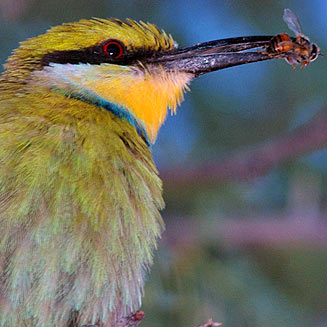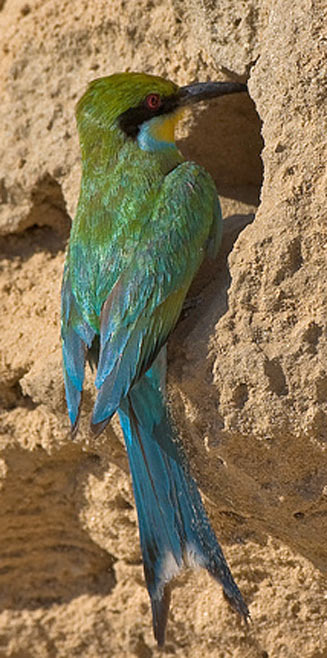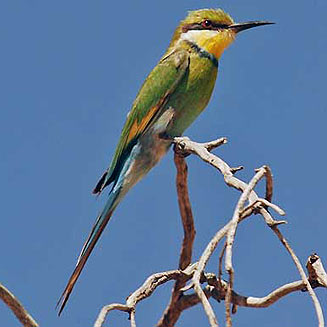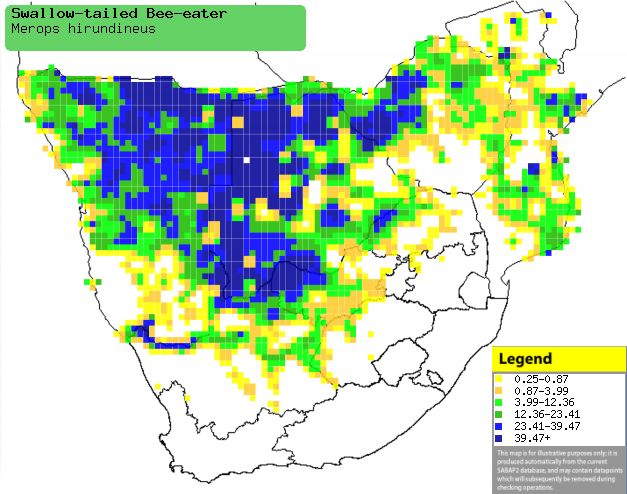|
Merops hirundineus
(Swallow-tailed bee-eater)
Swaelstertbyvreter [Afrikaans]; Sitembandayi (generic term
for non-Carmine bee-eaters) [Kwangali]; Morôkapula (generic term for bee-eater)
[Tswana]; Zwaluwstaartbijeneter [Dutch]; Guępier ŕ queue d'aronde [French];
Schwalbenschwanzspint gabelschwanzspint [German]; Abelharuco-andorinha
[Portuguese]
Life
> Eukaryotes >
Opisthokonta
> Metazoa (animals) >
Bilateria >
Deuterostomia > Chordata >
Craniata > Vertebrata (vertebrates) > Gnathostomata (jawed
vertebrates) > Teleostomi (teleost fish) > Osteichthyes (bony fish) > Class:
Sarcopterygii (lobe-finned
fish) > Stegocephalia (terrestrial
vertebrates) > Tetrapoda
(four-legged vertebrates) > Reptiliomorpha > Amniota >
Reptilia (reptiles) >
Romeriida > Diapsida > Archosauromorpha > Archosauria >
Dinosauria
(dinosaurs) > Saurischia > Theropoda (bipedal predatory dinosaurs) >
Coelurosauria > Maniraptora > Aves
(birds) > Order: Coraciiformes
> Family: Meropidae
 |
 |
 |
| Top left: fig.1 - Swallow-tailed
bee-eater bee in its bill. Bottom right: Swallow-tailed bee-eater.
[photos
Callie de Wet ©] |
Right: fig. 3 - Swallow-tailed at entrance hole
of nest. [photo Gerhard Theron ©] |
The Swallow-tailed bee-eater is occurs in West, East and
southern Africa, preferring tall savanna woodlands and Eucalyptus
plantation. It feeds exclusively on insects, mostly bees, but also wasps,
dragonflies, beetles amongst others. Both sexes excavate the nest, which
consists of a short tunnel widening into an egg chamber. It is usually dug into
sandbanks or riverbanks. The female lays 2-4 eggs, at one day intervals. Very
little is known of the chicks, other than they are fed butterflies, bees and
wasps by both sexes.
Distribution and habitat
Occurs in sub-Saharan Africa, excluding the equatorial
forest belt; in southern Africa it
is locally common in Namibia, Botswana, Zimbabwe, Mozambique and northern South
Africa. It generally prefers tall savanna woodlands, with trees such as Zambezi
teak (Baikiaea plurijuga), Burkea (Burkea africana), miombo (Brachystegia),
bushwillows (Combretum) and Mopane (Colophospermum mopane). It also
occasionally moves into Eucalyptus plantations.
|
 |
|
Distribution of Swallow-tailed bee-eater in
southern Africa, based on statistical smoothing of the records from
first SA Bird Atlas Project (©
Animal Demography unit, University of
Cape Town; smoothing by Birgit Erni and Francesca Little). Colours range
from dark blue (most common) through to yellow (least common).
See here for the latest distribution
from the SABAP2. |
Brood parasites
It has been recorded as host of the
Greater honeyguide.
Food
Exclusively eats insects,
especially bees. It usually spots
its prey from low perches, rapidly flying at the insect once it has been
located. It kills its prey by repeatedly banging it against the perch. If it is
venomous, the sting is rubbed against its perch until all the venom has been
secreted. The following insects have been recorded in its diet:
Breeding
- Both sexes excavate the nest, which
consists of a short tunnel widening into an egg chamber. It is usually dug
into sandbanks or riverbanks (see fig. 3)
- Egg-laying season is usually from October-February, peaking from
September-November.
- It lays 2-4 eggs, at one day intervals.
- Very little is known of the chicks, other than they are fed butterflies,
bees and wasps by both sexes.
Threats
Not threatened, in fact well-represented in protected areas.
References
-
Hockey PAR, Dean WRJ and Ryan PG (eds) 2005. Roberts
- Birds of southern Africa, VIIth ed. The Trustees of the John Voelcker
Bird Book Fund, Cape Town.
|
